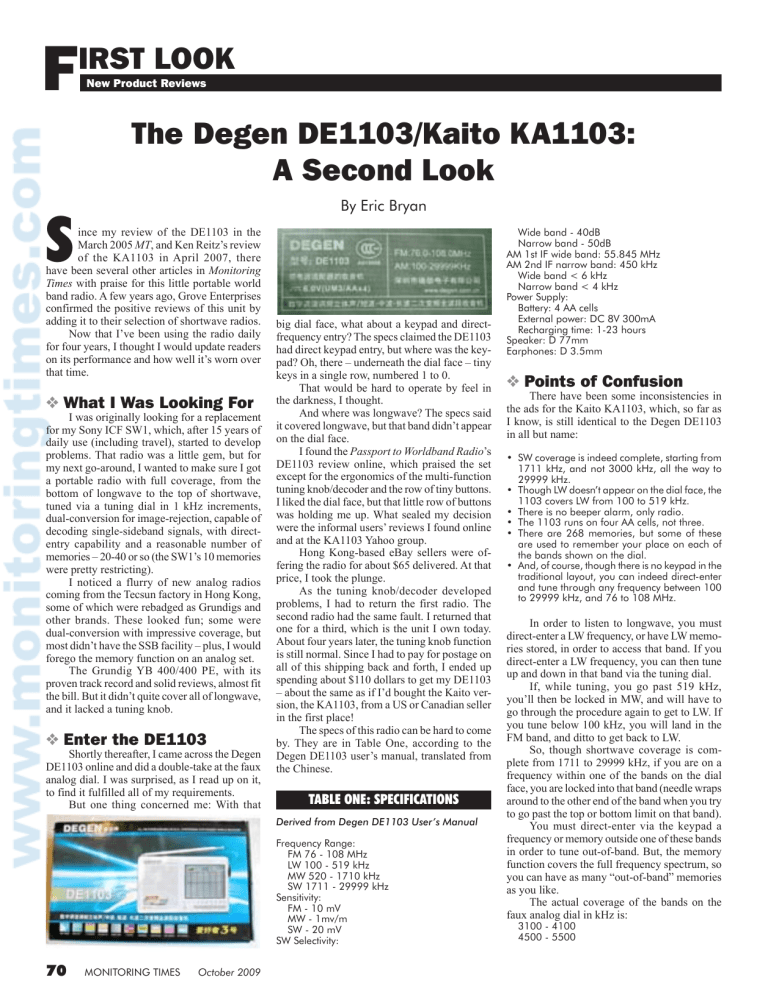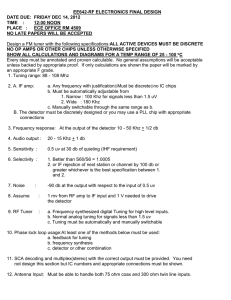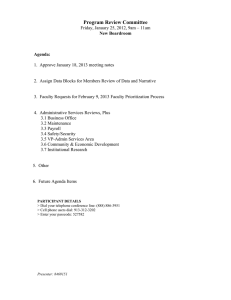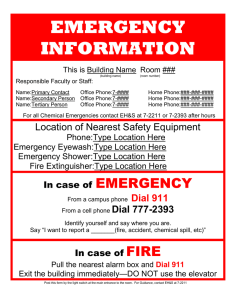Kaito 1103 - Monitoring Times

F
IRST LOOK
New Product Reviews
The Degen DE1103/Kaito KA1103:
A Second Look
By Eric Bryan
S ince my review of the DE1103 in the
March 2005 MT , and Ken Reitz’s review of the KA1103 in April 2007, there have been several other articles in Monitoring
Times with praise for this little portable world band radio. A few years ago, Grove Enterprises confirmed the positive reviews of this unit by adding it to their selection of shortwave radios.
Now that I’ve been using the radio daily for four years, I thought I would update readers on its performance and how well it’s worn over that time.
Wide band - 40dB
Narrow band - 50dB
AM 1st IF wide band: 55.845 MHz
AM 2nd IF narrow band: 450 kHz
Wide band < 6 kHz
Narrow band < 4 kHz
Power Supply:
Battery: 4 AA cells
External power: DC 8V 300mA
Recharging time: 1-23 hours
Speaker: D 77mm
Earphones: D 3.5mm
❖
What I Was Looking For
I was originally looking for a replacement for my Sony ICF SW1, which, after 15 years of daily use (including travel), started to develop problems. That radio was a little gem, but for my next go-around, I wanted to make sure I got a portable radio with full coverage, from the bottom of longwave to the top of shortwave, tuned via a tuning dial in 1 kHz increments, dual-conversion for image-rejection, capable of decoding single-sideband signals, with directentry capability and a reasonable number of memories – 20-40 or so (the SW1’s 10 memories were pretty restricting).
I noticed a flurry of new analog radios coming from the Tecsun factory in Hong Kong, some of which were rebadged as Grundigs and other brands. These looked fun; some were dual-conversion with impressive coverage, but most didn’t have the SSB facility – plus, I would forego the memory function on an analog set.
The Grundig YB 400/400 PE, with its proven track record and solid reviews, almost fit the bill. But it didn’t quite cover all of longwave, and it lacked a tuning knob.
❖
Enter the DE1103
Shortly thereafter, I came across the Degen
DE1103 online and did a double-take at the faux analog dial. I was surprised, as I read up on it, to find it fulfilled all of my requirements.
But one thing concerned me: With that big dial face, what about a keypad and directfrequency entry? The specs claimed the DE1103 had direct keypad entry, but where was the keypad? Oh, there – underneath the dial face – tiny keys in a single row, numbered 1 to 0.
That would be hard to operate by feel in the darkness, I thought.
And where was longwave? The specs said it covered longwave, but that band didn’t appear on the dial face.
I found the Passport to Worldband Radio ’s
DE1103 review online, which praised the set except for the ergonomics of the multi-function tuning knob/decoder and the row of tiny buttons.
I liked the dial face, but that little row of buttons was holding me up. What sealed my decision were the informal users’ reviews I found online and at the KA1103 Yahoo group.
Hong Kong-based eBay sellers were offering the radio for about $65 delivered. At that price, I took the plunge.
As the tuning knob/decoder developed problems, I had to return the first radio. The second radio had the same fault. I returned that one for a third, which is the unit I own today.
About four years later, the tuning knob function is still normal. Since I had to pay for postage on all of this shipping back and forth, I ended up spending about $110 dollars to get my DE1103
– about the same as if I’d bought the Kaito version, the KA1103, from a US or Canadian seller in the first place!
The specs of this radio can be hard to come by. They are in Table One, according to the
Degen DE1103 user’s manual, translated from the Chinese.
TABLE ONE: SPECIFICATIONS
Derived from Degen DE1103 User’s Manual
Frequency Range:
FM 76 - 108 MHz
LW 100 - 519 kHz
MW 520 - 1710 kHz
SW 1711 - 29999 kHz
Sensitivity:
FM - 10 mV
MW - 1mv/m
SW - 20 mV
SW Selectivity:
❖
Points of Confusion
There have been some inconsistencies in the ads for the Kaito KA1103, which, so far as
I know, is still identical to the Degen DE1103 in all but name:
• SW coverage is indeed complete, starting from
1711 kHz, and not 3000 kHz, all the way to
29999 kHz.
• Though LW doesn’t appear on the dial face, the
1103 covers LW from 100 to 519 kHz.
• There is no beeper alarm, only radio.
• The 1103 runs on four AA cells, not three.
• There are 268 memories, but some of these are used to remember your place on each of the bands shown on the dial.
• And, of course, though there is no keypad in the traditional layout, you can indeed direct-enter and tune through any frequency between 100 to 29999 kHz, and 76 to 108 MHz.
In order to listen to longwave, you must direct-enter a LW frequency, or have LW memories stored, in order to access that band. If you direct-enter a LW frequency, you can then tune up and down in that band via the tuning dial.
If, while tuning, you go past 519 kHz, you’ll then be locked in MW, and will have to go through the procedure again to get to LW. If you tune below 100 kHz, you will land in the
FM band, and ditto to get back to LW.
So, though shortwave coverage is complete from 1711 to 29999 kHz, if you are on a frequency within one of the bands on the dial face, you are locked into that band (needle wraps around to the other end of the band when you try to go past the top or bottom limit on that band).
You must direct-enter via the keypad a frequency or memory outside one of these bands in order to tune out-of-band. But, the memory function covers the full frequency spectrum, so you can have as many “out-of-band” memories as you like.
The actual coverage of the bands on the faux analog dial in kHz is:
3100 - 4100
4500 - 5500
70
MONITORING TIMES October 2009
5500 - 6500
6500 - 7500
9000 - 10000
11450 - 12450
13450 - 14450
14950 - 15950
17050 - 18050
20950 - 21950
Again, to tune outside of these frequency limits, direct-enter a frequency or go to a memory not covered on the dial face.
❖
Biggest Drawbacks
When this radio first came out, the major complaints were about the volume control – you must pres the VOL button, then adjust the volume with the jog dial, or you can direct-enter a volume level with the keypad. Having used the radio for several years, this is not a problem for me. I almost always use the jog dial method of volume control.
I’ve found the main bugaboos in operating the 1103 are:
• Not being able to tune continuously up the 41 meter band past 7500 kHz; you have to enter a frequency above 7500 kHz in order to tune that section of 41 meters. Usually, I enter 7600 kHz, and tune down.
• The calibration isn’t perfect on my unit. The tuner likes to be set 1 kHz below the actual frequency, so WWV on 10000 kHz is always
9999 kHz. I’m used to this, but now all of these 1 kHz-off frequencies are ingrained in my mind, so when I think of Croatian Radio on
31 meters, it’s 9924 kHz, etc. This is annoying when reporting a logging, and I accidentally write it as 1 kHz off, or read a frequency listing and forget to make the mental conversion.
• On the keypad, the buttons aren’t perfect, and the “6” button sometimes doesn’t take, causing another try or two to enter my frequency.
• Though I liked the dial face at first, I find I don’t use it, always relying on the digital readout.
The LCD needle/indicator jumps in 25 kHz increments on SW, so it can read up to 24 kHz off, making it of limited use.
For operating by feel at the bedside at night, or for blind users, the traditional telephone keypad layout would be easier. (Though now
I’m so used to operating it at night in memory mode, tuning up and down with the jog dial through my selected memories, this isn’t as big an issue for me.)
• In the same vein, when operating by feel, it’s hard to access a memory by direct-entry. You have to first enter the memory’s number on the keypad, then find the M/F button in the upper left corner of the radio, and press that.
With the linear keypad layout, it’s an impractical exercise in the dark.
Again, the way to access your memories in this situation is to enter memory mode, and cycle through your memories by the jog dial.
• The scan in 5 kHz increments on SW is so slow
I never use it – it’s faster to just use the tuning dial.
❖
Biggest Pluses
The first one is easy and it’s a biggie, but I
Kaito KA-1103
NEW! Dual Conversion, Digital Entry, AM/FM-stereo/mono, Shortwave Radio with SSB
Kaito's latest entry into the multiband portable market may look like an analog-dial radio, but it's actually a precision PLL circuit with 1 kHz steps and digital LCD readout! It tunes 76-108 MHz FM and also continuous 522-
29900 kHz AM and shortwave—and it has infinite clarifying SSB as well!
This powerful, dual-conversion portable also has 190 memory channels (10 pages of 19 + 1 page for SSB) to store your favorite stations, and runs off 4 Ni-MH AA rechargeable batteries (included) and AC; an automatic charger/adaptor is provided.
Just look at these additional specifications:
268 memory presets (Dynamic memory on 19 Pages) with autoscan
Beeper, radio and sleep clock/alarm
Manual or direct-entry frequency tuning
Electronic volume set
Smart charger with count-down timer and battery power/charge indicator
Meter band to frequency conversion
3 backlight modes
LCD bar graph signal strength indicator
External speaker, earphone, line output and antenna jacks
Auto reset prevents deadlocking
Extra-long telescoping antenna improves reception
DX/LOCAL switch to prevent front-end overload
FM mono/stereo selection
Music/news (voice) tone control with “Super bass” selection
Measures only 6.5”W x 4”H x 1”D
800-438-8155
Order
Now
!
Order RCV55
Only $ 89 95*
828-837-9200 fax: 828-837-2216
www.grove-ent.com
order@grove-ent.com
7540 Highway 64 West
Brasstown, NC 28902
* plus $9.95 Priority Mail or UPS Ground shipping in the US
October 2009 MONITORING TIMES
71
forgot to mention it in my initial review:
• The memory function remembers the mode – AM or SSB – of that memory/ frequency. There is a ham channel I sometimes listen to at night, where they broadcast in SSB, and it has been a snap to go into memory mode and tune up and down with the jog dial through my entered memory frequencies from FM, into MW, and on into SW, without having to manually go in and out of SSB mode.
This is a gigantic advantage for bedside operating-by-feel listening. I can’t imagine now having to punch in and out of SSB mode. Plus, the 1103’s
SSB is stable, so rarely do I have to fine tune that SSB signal that’s in my memory (once it’s been initially tuned in). I would find it hard to do without this function, now.
• The radio has fallen off the nightstand and landed hard several times with no serious permanent damage. Sometimes the fine tuning gets knocked askew, so I have to retune my stored SSB frequency, but that’s all.
• Sensitivity and selectivity have been good across all the bands, with the narrow IF usually doing the trick when I need to separate closely-spaced SW signals.
• It’s been freeing to get away from button-only tuning to the tuning/jog dial on the 1103.
Using the tuning dial in memory mode is very handy and the way to go for regular bedside listening, unless you’re exploring for new signals.
• The built-in battery charger has been great, eliminating the hassle of regularly removing and inserting batteries.
❖
Wear
Though it’s survived the falls and knocks well, there are a few little signs of wear on the
1103 to note:
• Number one is the headphone jack has become a little temperamental – sometimes I have to rotate and fiddle with the mini-plug in order to get a full connection.
• The slider switches have become, at times, scratchy.
• The paint has worn off the oft-used BAND- and
BAND+ buttons.
The telescopic antenna suffered a little damage, but was my fault, being bent in a fall. Any other slight dings have also been from knocks and falls.
The only other wear notes to add are the demise of the Degen earphones, which had the best sound of any mini-phones I’d ever used; and the snarling and damage to the included wire antenna, which was prone to injury because it had no facility for winding or storage.
❖
Performance
I’ve never seen another shortwave radio where it performs almost equally well, whether with the extended whip or on an indoor wire. Just about everything that’s audible with the wire is as good or almost as good with the whip.
One thing I learned when struggling with a shortwave signal that was being crushed by noise or interference of some kind, was that it pays to try all the power, antenna, and sensitivity options and combinations possible. I was trying to listen to one of the Central or Eastern European stations which was being clobbered with noise, when I started to experiment with DC versus AC power, the wire antenna versus the whip extended to various lengths, and the settings of the LOCAL/DX switch.
Though there is a considerable drop in RF when switching to DC/battery power, I found that this lowering of sensitivity also decreased the noise or interference. Further, while running on DC, unhooking the wire and receiving over a partially extended whip, the European signal, though weaker, was now set in a background of quiet, and was just listenable. (The AC power supply does cause buzz on AM and 90 and 75 meters shortwave, but is not usually a problem in the higher shortwave spectrum.)
Other combinations – running on AC with the switch set to LOCAL, both with and without the wire antenna; running on DC with the switch set to DX, but with the wire, etc. – all produced varying effects, and usually an improvement over my standard mode of running via AC with the switch set to DX and using the wire antenna.
The general effect of all these methods was a lessening of sensitivity, but a more listenable, though sometimes weaker signal, with noise or interference decreased or eliminated.
Here in the Northwest, I believe I’ve caught all of the Central and Eastern European international shortwave stations with the 1103.
When conditions are decent, Egypt and Argentina have been listenable. Greece on 9420 or
7475 kHz is pretty reliable. Gabon on 15475 and Jordan on 11690 are regular. Also
Morocco and Tunisia are semi-regular.
Turkey (from Turkey, not relayed) and Galei Zahal in Israel are occasional catches. Good old Rai/Italy on 11800 used to be daily (a frustrating loss, there). I would sometimes get Libya, and once caught a clandestine in Moldova.
The Voice of Nigeria and Channel Africa are pretty routine catches. All of this with a portable, randomly-strung indoor wire, or with the whip.
I’m sure, in a quiet area with less local noise and with an outdoor antenna, many more tropical and other more challenging stations could be had with the 1103. I regularly hear hams in SSB in
Spanish, probably in Central or South America.
I also hear hams in SSB speaking in Chinese or a related language, though whether they are transmitting from ships at sea, or the Far East,
I can’t say. Several Australian hams have come in over SSB, too.
❖
Should You or Shouldn’t
You?
For the price (about $100 delivered from
Grove), getting a dual-conversion, full-coverage LW/MW/SW/SSB radio (plus extended
FM) that tunes in 1 kHz increments via a tuning knob, with excellent sensitivity and selectivity for any portable, despite some of the ergonomic challenges, is a good deal.
You can always pay less by ordering the radio from Hong Kong/China through eBay – but be forewarned by my experience of paying for shipping three times over in order to get a correctly working unit.
I’ve mostly overcome the ergonomic issues. When using the radio in the light, or during the daylight, there’s no problem with direct-entering frequencies, etc. A blind radio enthusiast might want to think twice, since the dial face will be useless for them, combined with the lack of a traditional keypad layout.
There is a slight ridge on the “5” button to help you get your bearings by touch, but the buttons are tiny and the ridge even tinier. Plus, once you’ve found it, you have to count your way out either side of the 5 button.
At least 1 and 0, at either end, are easy to find.
Despite being a portable, with a size of about 6.5 x 4 x 1 inches, you can truly DX with this radio. I think, being able to do that for around $100
– possibly more or less – makes it a good deal. Other comparable units start at about $150 – some with easier ergonomics, but some without the coveted tuning knob (which is a huge ergonomic plus!).
So, if the 1103’s peculiarities don’t bother you, it looks as though it’s the best deal available right now in a dual-conversion portable world band radio.
I think, if it looks right for you, yes, you should.
72
MONITORING TIMES October 2009
MT
PRESS
SPECIAL
OFFER
BELOW!
Going Green has never been more exciting!
Before the rising prices of gasoline, and before going “green” became a sales pitch, Monitoring Times created MT Express. The full version of the magazine you’ve come to depend on, in full electronic form. Now going into our 11th year of digital perfection, MT Express is better than ever. You get more with our digital magazine than you could ever have with print. The entire magazine is full color. All of the web links are clickable, so if you see a link to a website that you want to visit, just click on it! Want to email an author? Just click on their email address at the top of their column, and MT Express opens your email program, drops in their address, and is ready for your input! All of this, and it’s even CHEAPER than the regular print version!
Plus, you’ll get it faster than you would your print copy, no matter where you are in the world. Now is the time to make the switch to digital. Sure, it’s saving a tree and saving some gas, but it’s also getting you what you need, when you want it. Make the switch today.
For a mere $19.95 U.S.,
MT Express gives you Monitoring
Times magazine in PDF format viewable with free software, delivered by FTP viewable in b r i l l i a n t c o l o r (the whole magazine, not just what you see in the print version) on your computer screen easily navigated by clicking on the Table of Contents printable using your own computer printer searchable to find every mention of a topic or station schedule importable into your frequency databases compatible with software to convert text to audio for sight impaired listeners
Now with
MT
TRA
Not only do you now have the complete
Monitoring Times magazine, in full color, but for no have a worldwide broadcast guide with ALL offered languages, not just English! So no matter where you are in the world, Monitoring Times has something just for you!
To find out if this new subscription is the delivery solution for you, you may download a sample issue for free! Just go to http://www.grove-ent.com
to find out how.
If you order NOW , you will get price of 12! That’s right, for
14 ISSUES only $19.95
for the you’ll get an EXTRA 2 MONTHS AND MT
X
TRA
!
Just mention code MTOCT09 when you place your order!
800-438-8155
828-837-9200 fax: 828-837-2216


